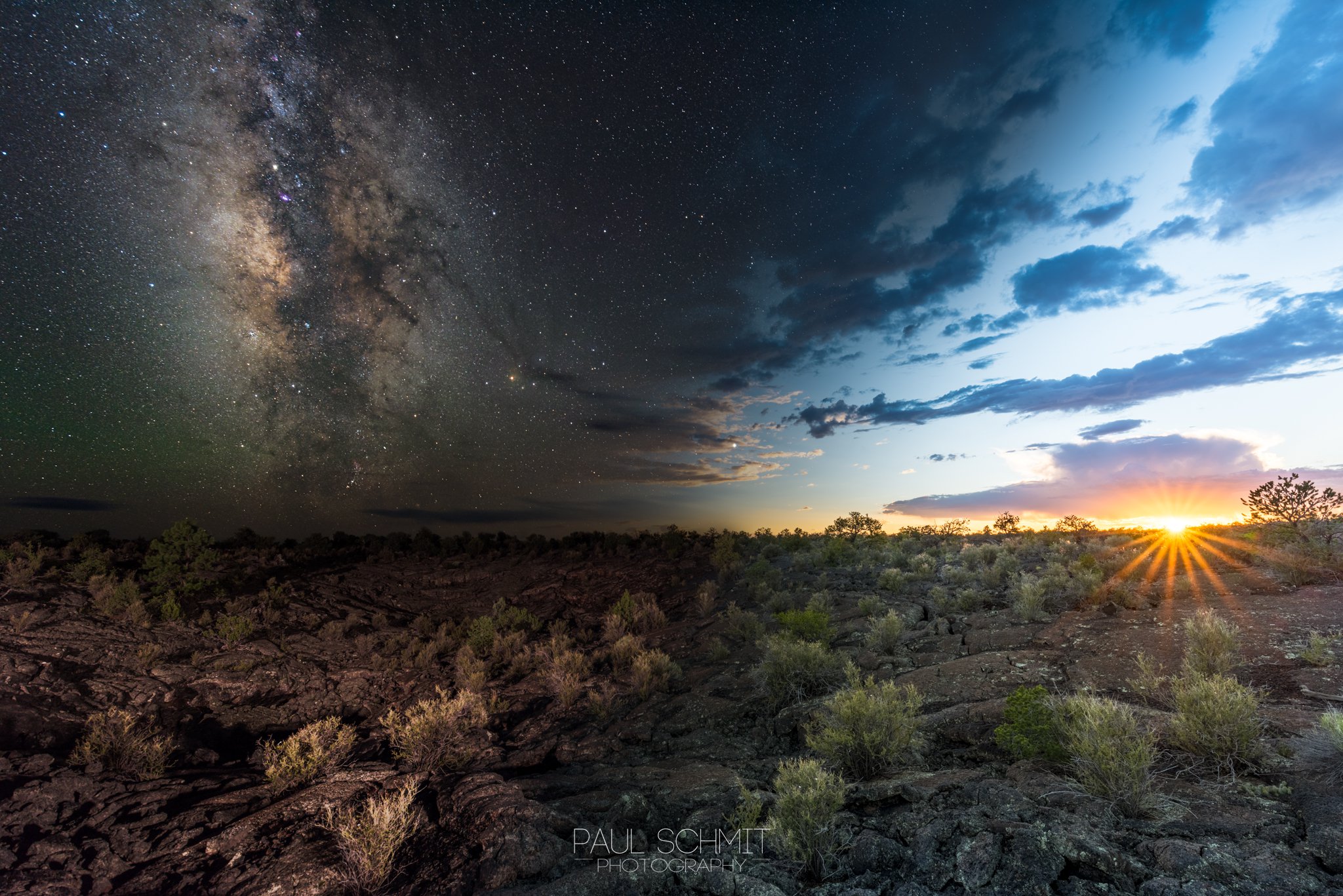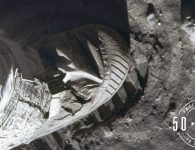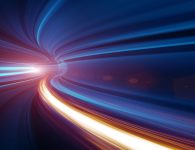

My name is Paul Schmit, and today I want to describe to you the journey that led to the time-blended astrolandscape you see above.
You might recognize me from my recent marathon endeavor to capture the International Space Station crossing in front of the sun at sunrise. By day, I’m an award-winning theoretical physicist working at the frontiers of nuclear fusion research on the world’s most powerful electrical sledgehammer, the Z Machine. By night (quite literally) I’m an avid astrolandscape photographer striving to push my technical skills and creativity to their limits in an effort to make my own modest contributions to a photographic community crawling with incredibly talented image makers.
About a year ago, overflowing with inspiration and racking my brain trying to conjure visions of what sorts of “roads less traveled” might be out there in the astrolandscape world, I happened upon a neat realization in my living room while playing with the Photographers Ephemeris (TPE) app.
It turns out that in late summer, in the midlatitudes of the Northern Hemisphere (a.k.a. my part of the world), it is possible to point an ultra-wide-angle lens toward the southwest and capture the setting sun on the right side of the frame, and then, after the last hints of daylight disappear from the horizon (a couple hours later), capture the dense, luminous core of our home galaxy, the Milky Way, moving through the left side of the frame, all without any need to reposition the camera.
Thus, a two-hour shoot from a fixed position could yield opposing perspectives of two dramatic celestial events, each casting different colors, shadows, and moods over the same patch of earth. With some clever blending in post, I reasoned, I could create an image telling two different stories simultaneously, yet inextricably linked by their common foreground. I had to try it. And, as you read on, I’ll be sharing a few thoughts and tips on why I really enjoy this style, and why you might want to give it a try, too.
This is the image that got the ball rolling for me: Transition.

In September 2018, my father and I hiked across an ancient lava flow spilling across the northern New Mexico landscape in search of a foreground that would play equally well with the tones and textures of the late-day and nighttime environments. It amazed me to see such a diversity of tenacious lifeforms springing from the cracks and crevices of what was surely an apocalyptic scene eons ago.
Late in the day, I set up my camera to immortalize a slice of this landscape, placing the setting sun on the right side of the frame. I clicked off a bracketed sequence as the sun descended beneath a fortuitously positioned late-summer storm, which cleared the area after dusk, readying the sky for a clear view of our home galaxy. Sure enough, as the sky became truly dark, the ethereal glimmer of 100 billion stars cast a dim glow across the weather-worn lava flow, appearing just to the left of where the sun had set just a couple hours earlier.
Back at home, as I worked on constructing the final blended image, I found that the late-day clouds and lichen-adorned basalt created the sorts of pleasingly varying textures across which I could portray the night side of the image gently, perhaps even ominously creeping into the day side. My first time blend was completed.
When I released this image on social media and several night photography forums, I was delighted to hear how much it resonated with so many individuals. Some fellow photographers were also keen to point out the work of Stephen Wilkes, an acclaimed photographer famous for his Day To Night™ series, where he captures hundreds of images of iconic scenes over several-hour periods and then elegantly blends them into single, flowing compositions.
Since discovering Stephen’s work for myself, I have found limitless inspiration studying his style, technique, and compositional choices. He truly is the master of the blend. My hope in beginning my own foray into this genre is perhaps to more evenly emphasize the changing auras of both the terrestrial foregrounds as well as the celestial backgrounds with the passage of time, firmly planting my images within the broader astrolandscape realm.
Tip: Astrolandscape images often benefit from cleverly placed, very dim artificial light sources—a technique referred to as Low Level Lighting. The goal is to provide just enough even illumination to balance the luminance of the night sky with the often darker, starlit landscape within a single exposure.
For Transition, I had two LED panels set atop light stands a fair distance away on either side of the camera to accentuate the textures of the lava without casting harsh shadows. The depth of the scene proved to be difficult to manage tastefully with only two lights. A better place to get started with LLL are foreground subjects with more limited depth and breadth, like a tree, a cactus, a natural arch, a cabin, etc. In these cases, one or two off-camera LED lights can be more than enough to produce a pleasing effect.

Thrilled by my first endeavor in time-blended astrolandscapes, I found myself a month later perched atop an 11,000-foot-high caldera, watching the sun descend toward the horizon as I worked out my next composition.
Originally, my plan was to capture the sun and the Milky Way straddling both sides of the peak of this mountain, Mt. Taylor, but the antiquated fire lookout seen on the left side of the frame was too irresistible to leave out of the composition, aptly dubbed Aerie. Improvising on the spot, I endeavored to try something new: capture the sunset and nighttime images in a panoramic mosaic, rather than a single frame.
Time management and thoughtful anticipation of post-processing tribulations were essential here, as the ambient light and sky orientation were constantly changing during the different phases of the shoot, and the difficulty of aligning and blending two different sets of stitched images promised to be much greater than the case where the camera was fixed in place for the entire shoot.
I quickly rattled off a few 6-vertical-panel x 7-exposure bracketed sets of images at sunset (42 images total for the day side of the image) to use for an HDR panorama. Then, as a stiff, frigid breeze enveloped the mountain peak after nightfall, I did my best to capture identical long exposures of the same 6 panels, and then quickly gathered my camera and LED lights (which were wrapped in white t-shirts at the base of the lookout to provide some dim illumination) and threw them into the back of my vehicle before the temperatures plunged further.
Tip: Perfectly aligning day and night images of the same scene can be a nontrivial task, which only gets more difficult when working with panoramas that may have stitched slightly differently. I align my images manually in Photoshop by first picking a reference image (say, the sunset image) and setting that as my background layer. Then, I’ll place the other image in a new layer and use the incredibly useful Puppet Warp tool to apply minute corrections to small patches of the top layer until I no longer see signs of ghostlike duplications of prominent features in the landscape caused by imperfect overlap.
For identical exposures of a scene taken at only one time, the difference blending mode is a great to aid the alignment process, but with two images captured at different times and different exposure levels, I play around with other blending modes, too, such as the exclusion and divide blending modes. Reducing the top layer’s opacity can also help your eye pick out misalignments of fainter features that may not be apparent at first glance.

This next image, While the Cranes Slept, originally wasn’t supposed to be a time blend. This was the end result of a frigid but delightful all-nighter spent with my dad near the Bosque del Apache National Wildlife Refuge during the peak of the Geminids meteor shower in late 2018.
My goal that night was to capture two compositions that captivated my imagination, the first of which required impeccable timing and positioning, and which will be a subject of a future tutorial. With whatever time I had left before dawn, chilled to the bone by several hours of exposure to the 15-degree weather, I wanted to capture a wide-angle panorama of the winter Milky Way draped over a flock of sleeping sandhill cranes while more than a dozen meteors rained out of the sky every minute.
When I arrived at one of the crane ponds and located the sleeping birds, I was disheartened to find that they had cunningly placed quite a bit of distance between themselves and the shore, preventing me from getting close enough to them to fill the whole lower part of the frame with the flock. Adjusting my composition, I spent the last 90 minutes of darkness shooting a 3-panel vertical panorama, bouncing back and forth between the three panels repeatedly to capture more meteors while the slightly annoyed cranes squawked at me from their aqueous abode.
Knowing that they were going to turn out rather small and nearly indistinguishable in the final image—a far cry from my original concept—I decided to stick around until dawn to capture a second panorama. In the final image, I use the pleasant blues and purples of the early-morning sunlight to draw the viewer’s eyes toward the cranes, now awakening from their slumber, blissfully ignorant to the fireworks that concluded overhead just an hour earlier.
Tip: As is the case in While the Cranes Slept, time blending can be used to accentuate or create entirely new leading lines drawing the viewer into a scene. When time and energy permit, sticking with a compelling composition and capturing it under a variety of different lighting conditions can afford entirely new creative opportunities to tell a unique story.

There isn’t just one time an interesting astronomical alignment between the Milky Way and the sun occurs. Just as late summer affords views of sunset and the Milky Way in close proximity to one another in the Northern Hemisphere, early spring provides conveniently juxtaposed views of sunrise and our galactic core perfect for time blending.
For this image, Flow of Time, I wanted to use a panoramic view of the winding Rio Grande River Valley to weave together the various colors and textures of the captivating landscape under the entire palette of available ambient light, from darkness to sunrise.
To this day, I’ve never worked harder to obtain and produce an image than I did here.
Straddling uneven boulders forming a roughly 10-foot wide spine flanked by precipitous drops into valleys below, I struggled until the final moments of darkness trying to compose a multi-frame panorama featuring this intrepid, daredevil cholla cactus accompanied by unobstructed views of the Rio Grande, all while dealing with the growing pains of integrating a new star tracker into my workflow.
After finally finding a great camera position, with my tripod jimmied up against the side of a large boulder, I spent the next couple hours capturing multiple panoramic mosaics of the night sky, the twilight “blue hour,” and sunrise over the distant, snow-capped Sangre de Cristo mountains.
Aligning the stitched panoramas took an incredible amount of manual labor, this time involving not two unique times to register, but three. However, having the moody blues of the early-morning twilight image to smooth the transition between day and night really enhances the fluidity of the blend.
Tip: Capturing a wide-angle landscape scene with close-by foreground subjects can stretch the limits of a lens’ depth of field pretty quickly, especially when shooting nocturnal astrolandscapes at maximum aperture.
Focus stacking has become a preferred technique to maximize depth of field under uniform lighting conditions and with static subjects; however, the same small aperture, high-f-number settings that produce brilliant sunstars can also enhance the depth of field of a sunrise/sunset landscape image, allowing sharp renderings of both nearby foreground subjects and features at infinity. In a time blend, when the composition calls for it, blending the daylight version of an image into the portions containing close-in subjects can supplant the need for focus stacking the images taken at other times.

And, finally, we arrive at my latest time-blended image: Sinuous. This shot is all about mood, mood, mood. I captured this gorgeous tree near Ghost Ranch, a favorite haunt of the famed 20th-century artist, Georgia O’Keefe, and one of the most scenic natural treasures that can be found in northern New Mexico.
Really, as soon as I saw this tree, there was no escaping it. The writhing, grasping nature of its branches and fractal-like textures are a perfect setting to lose oneself between night and day. As the afternoon sun began to set, I was dismayed that the puffy white clouds that dotted the sky just an hour earlier had almost completely dissipated, robbing the sunset of some of its potential splendor. To make matters worse, the clouds came roaring back after nightfall, when outflow from distant thunderstorms intruded into my area.
I wound up sticking around for almost an hour later than I originally anticipated, just hoping the Milky Way would peek out from behind the cloud bank before it was too late. Finally, the familiar ghostly glow of the core partially emerged, and I captured the fleeting sight.
This was one of those moments that seemed severely compromised by the whims of Mother Nature, so I was pleasantly surprised to return home and discover how complementary the day and night sides of the image turned out to be, with the day side conveying a sense of tranquility and grandeur, and the night side an ominous, looming atmosphere. The blowing dust that had been an annoyance at sunset wound up restoring some vibrant colors to the cloudless sky, while the clouds completely redefined the atmosphere of the night image in a manner almost better matched to my serpentine, haunting foreground.
Tip: Sometimes the composition calls for focus stacking, as was the case for Sinuous. The concept hinged on the tree living halfway between light and darkness, and I didn’t have the depth of field in the night shots to capture the tree and sky in perfect focus at the same time.
In cases like this one, beware of focus breathing effects, even when shooting at fixed focal length. My close-up and infinity-focus night shots were about 1-2% different in scale despite not touching the zoom ring, and I had to rescale the images accordingly to produce a near-perfect blend in post.
Bonus Tip: In my year of shooting a variety of time-blended astrolandscapes, I’ve come to find that the composition hinges critically on the foreground choices, no matter the convenience and spectacle of the astronomical alignments happening in the sky. In my opinion, foregrounds with lots of depth, contours, and texture variations offer the greatest opportunities to showcase the contrast in moods achieved under different lighting conditions, and they also often lend themselves to compelling blending tactics.
In my earlier images, Aerie and Flow of Time, I used the mountains to cast false shadows serving as the natural boundaries between day and night. Rough, jagged boulders just beg for a soft transition allowing night tones to creep toward the receding daylight; and rugged, meandering trees provide a “crackled paint” sort of look, superimposing disruptive patterns across the otherwise soft, ethereal transition between daylight and darkness.
I hope you’ve enjoyed this primer on the spectacular creative opportunities that time blending can bring to astrolandscape photography, or really any other kind of artistic image making. To keep up with my own ongoing photographic exploits, feel free to follow me on Instagram and check out my website!
![]()
read more at https://petapixel.com by Paul Schmit
Photography
















